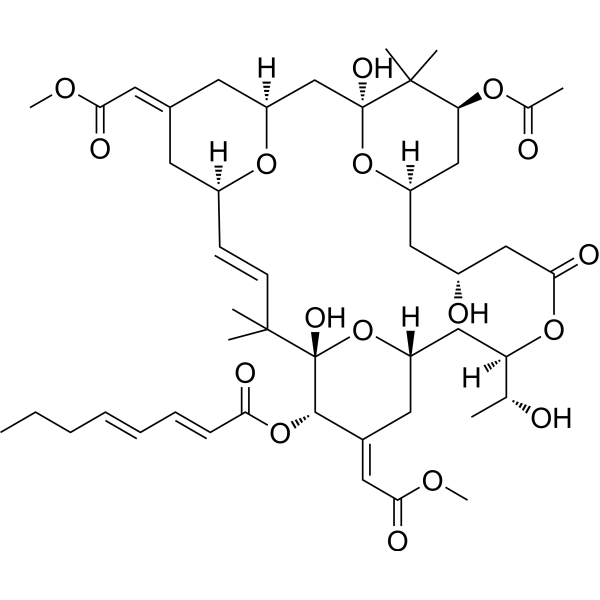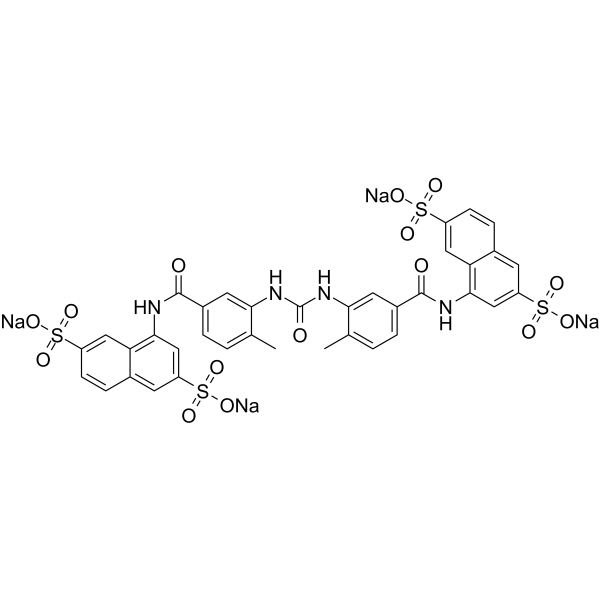 To enhance service speed and avoid tariff delays, we've opened a US warehouse. All US orders ship directly from our US facility.
To enhance service speed and avoid tariff delays, we've opened a US warehouse. All US orders ship directly from our US facility.
| Cat. No. | Product Name | Field of Application | Chemical Structure |
|---|---|---|---|
| DC11038 | Bryostatin 1 Featured |
Bryostatin 1 (NSC 339555) is a macrocyclic lactone derived from a marine invertebrate, fuctions as an activator of PKC with high binding affinity (Ki=1.35 nM).
More description
|

|
| DC71349 | NF340 Featured |
NF340 is a potent and selective P2Y11 receptor antagonist. NF340 inhibits the activity of P2Y11R by completely combining with ATP-binding amino acid residues. NF340 ameliorates inflammation in human fibroblast-like synoviocytes and can be used for rheumatoid arthritis research.
More description
|

|
| A1105 | Zanidatamab Zovodotin Featured |

|
|
| A1104 | Tusamitamab ravtansine Featured |
Tusamitamab ravtansine (SAR-408701) is a targeted ADC against tumor cells expressing CEACAM5, composed of a humanized anti-CEACAM5 monoclonal antibody covalently linked to the potent cytotoxic agent, maytansinoid DM4 (HY-12454), via a cleavable linker. Tusamitamab ravtansine has an average drug-to-antibody ratio (DAR) of 3.8.
More description
|

|
| A1103 | Vadastuximab talirine Featured |

|
|
| A1102 | Anetumab Ravtansine Featured |
Anetumab ravtansine (BAY 94-9343) is a selective and highly potent antibody-drug conjugate (ADC) to target maytansinoid tubulin. Anetumab ravtansine consists of a human anti-mesothelin antibody conjugated to the maytansinoid tubulin inhibitor DM4. Anetumab ravtansine shows antitumor efficacy correlated with the amount of mesothelin expressed in patient-derived xenograft tumor models.
More description
|

|
| A1101 | Mirvetuximab soravtansine Featured |
Mirvetuximab soravtansine (IMGN853) solution is an anti-folate receptor α (FRα) antibody drug-conjugate (ADC) consisting of the cytotoxic maytansinoid, DM4, covalently linked to the humanized monoclonal antibody M9346A, and the drug-linker conjugate for ADC is sulfo-SPDB-DM4 (HY-101141). Mirvetuximab soravtansine selectively binds to folate receptor 1 (FOLR1). Mirvetuximab soravtansine has an anti-proliferative effect via growth arrest and augmented DNA damage.
More description
|

|
| DC65476 | Serclutamab talirine Featured |
Serclutamab Talirine (ABBV-321), is an antibody-drug conjugate (ADC) composed of an humanized immunoglobulin G1 anti-EGFR monoclonal antibody conjugated to a pyrrolobenzodiazepine (PBD) dimer via a maleimidocaproyl-valine-alanine linker. Serclutamab Talirine has the potential for use in advanced solid tumors associated with overexpression of the epidermal growth factor receptor (EGFR) or its ligands.
More description
|

|
| A1100 | Rovalpituzumab tesirine Featured |
Rovalpituzumab tesirine (SC-002) is an antibody-drug conjugate (ADC) with anticancer effects. Rovalpituzumab tesirine contains a DLL3-targeting antibody Rovalpituzumab (HY-P99043) tethered to a cytotoxic agent pyrrolobenzodiazepine by means of a protease-cleavable linker. Rovalpituzumab tesirine can be used for the stduy of small cell lung cancer (SCLC).
More description
|

|
| A1099 | Cantuzumab ravtansine Featured |
Cantuzumab ravtansine (IMGN242; huC242-DM4), an ADC, is a humanized monoclonal antibody, huC242, covalently linked via a disulfide bond to DM4 (HY-12454). Cantuzumab ravtansine has broad antitumor efficacy against a range of CanAg-positive human tumor xenografts.
More description
|

|
| A1098 | Praluzatamab ravtansine Featured |

|
|
| A1097 | Labetuzumab govitecan Featured |
Labetuzumab govitecan (IMMU 130) is an Anti-CEACAM5/SN-38 antibody-drug conjugate (ADC). Labetuzumab govitecan consists of the antibody Labetuzumab, SN-38, and a pH-sensitive Linker. Labetuzumab govitecan can be used for research of cancers, such as colorectal cancer.
More description
|

|
| DC65458 | Denintuzumab mafodotin Featured |
Depatuxizumab Mafodotin (Depatux-M, ABT-414) is an antibody-drug conjugate consisting of an EGFR IGg1 monoclonal antibody conjugated to the tubulin inhibitor monomethyl auristatin F via a stable maleimidocaproyl link. Depatuxizumab Mafodotin is used in the treatment of recurrent EGFR-amplified Glioblastoma (GBM).
More description
|

|
| A1096 | Vorsetuzumab mafodotin Featured |
Vorsetuzumab mafodotin (SGN-75) is an Auristatin-based anti-CD70 antibody-drug conjugate (ADC). Vorsetuzumab mafodotin consists of a humanized monoclonal antibody, Vorsetuzumab and an ADC cytotoxin MMAF. Vorsetuzumab mafodotin has antineoplastic activity.
More description
|

|
| DC65470 | Belantamab Mafodotin Featured |
Belantamab mafodotin (GSK2857916) is a humanized, afucosylated, anti-B-cell maturation antigen (BCMA) monoclonal antibody-drug conjugate (ADC) conjugated to MMAF (HY-15579) via a maleimidocaproyl linker (McMMAF, HY-15578). Belantamab mafodotin shows anti-myeloma activity[1][2].
More description
|

|
| A1095 | Sacituzumab-MMAE Featured |

|
|
| A1094 | Brentuximab vedotin Featured |
Brentuximab vedotin (solution) (cAC10-vcMMAE) is an antibody-drug conjugate (ADC) comprising an anti-CD30 antibody and the cytotoxic agent Monomethyl auristatin E (MMAE). The antibody portion is Brentuximab (HY-P99151), and the drug-linker conjugate for ADC is VcMMAE (HY-15575). Brentuximab vedotin (solution) inhibits CD30-positive cells with an IC50 of 2.5 ng/mL. Brentuximab vedotin (solution) can be used for the research of relapsed and refractory Hodgkin lymphoma.
More description
|

|
| A1093 | Tisotumab Vedotin Featured |

|
|
| A1092 | Sirtratumab Vedotin Featured |
Sirtratumab vedotin (ASG15-ME) is an ADC composed of a SLITRK6-specific human gamma 2 antibody (Igγ2) conjugated to a small molecule microtubule disrupting agent, monomethyl auristatin E (MMAE) via a protease-cleavable linker.
More description
|

|
| A1091 | Gemtuzumab-IgG4-MMAE Featured |

|
|
| A1090 | Inotuzumab-MMAE Featured |

|
|
| A1089 | Pinatuzumab Vedotin Featured |
Pinatuzumab vedotin, an antibody-drug conjugate (ADC), is a CD22 humanized monoclonal antibody Pinatuzumab (HY-P99230) conjugated to VcMMAE (HY-15575). Pinatuzumab vedotin has antitumor activities.
More description
|

|
| A1088 | Ozuriftamab vedotin Featured |
Ozuriftamab vedotin (BA3021), an antibody-drug conjugate (ADC), is a conditionally active biologic (CAB) anti-receptor tyrosine kinase orphan receptor 2 (ROR2) humanized monoclonal antibody Ozuriftamab (HY-145626) conjugated to VcMMAE (HY-15575). Ozuriftamab vedotin has antitumor activities.
More description
|

|
| DC65460 | Zilovertamab vedotin Featured |
Zilovertamab vedotin (VLS-101, MK-2140) is an antibody-drug conjugate (ADC) composed of a humanised monoclonal antibody targeting ROR1 and the anti-mitotic cytotoxic agent monomethyl auristatin E (MMAE). It has potential for the treatment of lymphoid malignancies.
More description
|

|
| A1087 | Enfortumab vedotin-ejfv Featured |
Enfortumab vedotin-ejfv is an anti-Nectin-4 antibody-drug conjugate. Enfortumab vedotin-ejfv is a fully humanized IgG1 antibody conjugated to the microtubule disrupting agent MMAE (HY-15162) via a protease-cleavable Val-Cit linker. The antibody portion is Enfortumab (HY-P99016), and the drug-linker conjugate for ADC is VcMMAE (HY-15575). Nectin-4 is an adhesion protein involved in cellular processes and tumorigenesis, and Enfortumab vedotin-ejfv is indicated for the inhibition of locally advanced or metastatic urothelial carcinoma.
More description
|

|
| A1086 | Lorvotuzumab-MMAE Featured |

|
|
| A1085 | Lifastuzumab vedotin Featured |
Lifastuzumab vedotin (RG-7599; DNIB0600A) is an antibody-drug conjugate (ADC) that comprises a humanized IgG1 anti-NaPi2b monoclonal antibody (MNIB2126A) and a potent antimitotic agent, monomethyl auristatin E (MMAE), which inhibits cell division by blocking the polymerization of tubulin. Lifastuzumab vedotin has the potential for non-small cell lung cancer (NSCLC) and platinum-resistant ovarian cancer (PROC) research.
More description
|

|
| A1084 | Sofituzumab Vedotin Featured |
Sofituzumab vedotin (DMUC5754A) is a MMAE-containing anti-MUC16 antibody-drug conjugate (ADC) with a protease-cleavable linker. Sofituzumab vedotin can be used for the research of cancer.
More description
|

|
| A1083 | Oregovomab-MMAE Featured |

|
|
| DC65463 | Clivatuzumab-MMAE Featured |
Clivatuzumab-MMAE is an antibody-drug conjugate (ADC) composed of a humanized anti-mucin (MUC1) monoclonal antibody and a anti-mitotic cytotoxic agent monomethyl auristatin (MMAE).
More description
|

|